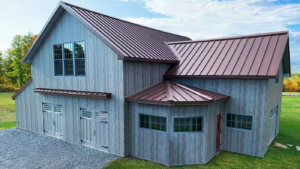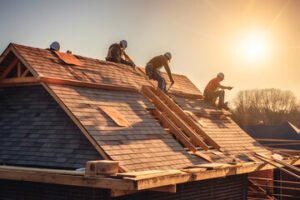Metal wall panels can enhance the aesthetic of any home design. They are highly versatile, durable, and require minimal maintenance.
Since steel is conductive, electrical safety must be taken seriously when working with it. Use heat-reflecting paint to keep metal surfaces cool and avoid hazardous arc flashes. This also helps the siding last longer. Contact Metal Siding Montana now!

Metal siding is one of the longest-lasting exterior cladding options. Unlike vinyl, it won’t fade or crack in intense heatwaves or icy winters and will retain its vibrant appearance with minimal upkeep. It’s also a great energy-efficient material, reflecting the sun’s rays to keep homes cool during summer and warm air inside during winter. This translates to lower energy bills and a smaller environmental footprint.
Homeowners today prioritize low-maintenance materials and sustainable solutions, and this is where metal siding shines. It’s manufactured using recycled materials and is fully recyclable at the end of its lifespan, reducing the need for natural resources and contributing to the preservation of the environment.
This sturdy and versatile siding option can match almost any design style, from the sleekness of urban lofts to the warmth of rustic countryside villas. It can be combined with wood or stucco to create a distinctive exterior, or complemented by other traditional features like windows and doors.
As with all exterior materials, proper maintenance is key to prolonging the life of metal siding. This includes periodic cleaning to remove dirt and dust buildup, which can reduce the effectiveness of the weatherproof coating. It’s also a good idea to conduct bi-annual inspections to check for signs of damage or wear and tear, such as scratches or dents. Addressing these issues early on can prevent them from escalating into more severe and costly problems down the road.
Metal siding can also be repainted as needed to refresh the color and protect against corrosion. A wide range of colors is baked into the cladding at the factory, and even steel siding that looks like a wood grain can be repainted with a Kynar-based PVDF paint system that offers up to 40 years of chalk and fade resistance.
If you’re considering switching to metal siding for your new home, contact a local professional to learn more about the options available and discuss your unique building needs. They’ll help you select the right thickness for your home, as well as a color that perfectly complements your design. They can also advise you on any local or state restrictions that may affect your project.
Durability
Durability is a key feature that distinguishes metal siding from other construction materials. It offers strong defense against harsh weather conditions, such as intense heat waves and icy winters, while resisting rot and pests. This sturdy material also provides energy-efficient properties by reflecting sunlight, keeping homes cool in summer and warm in winter.
If properly maintained, metal siding can last several decades, outliving many other construction materials. Nonetheless, it can be dented if struck by a solid object and can be scratched if exposed to abrasive surfaces. A simple way to decrease the chance of dents is to use a lower gauge metal, which is thicker and able to endure more force than thinner material.
Steel and aluminum are popular choices for siding, with galvanized steel being the most common option. A layer of zinc protects the underlying aluminum to prevent corrosion and increase longevity. Other materials that are often used in building construction include copper, stainless steel, and galvalume, a mix of aluminum, zinc, and silicon that increases the corrosion resistance of other metals.
Corrosion-resistant metals are ideal for coastal areas, as they withstand high humidity and salt content better than other types of metal. However, if you aren’t sure whether the type of metal you choose is suitable for your location, ask your contractor or consult a specialist in order to make the best decision.
In addition to its durability, metal siding is a versatile material in terms of design and style. It comes in a wide variety of colors, textures, and patterns to match any home aesthetic. You can also find different panel styles, including flat and shingle-like, to achieve the look you’re after.
The only drawback of metal siding is that it is heavier than other construction materials and requires special equipment for installation. This can add to your total project cost and extend the timeline for its completion. However, you can minimize this issue by choosing a trusted metal siding contractor that has experience working with steel. This way, you can be sure your home is built with the best possible materials and will look beautiful for years to come.
Recyclability
Many homeowners are prioritizing low-maintenance materials and sustainability, which is one reason why metal siding is gaining in popularity. This durable material is also highly recyclable and offers a beautiful aesthetic to any home. It also protects your building from harsh weather conditions, which is why it’s a popular choice for coastal areas and areas with harsh sunlight or rainy seasons.
Unlike other siding materials, which can dry rot or absorb water and develop mold and mildew, metal stands firm against harsh weather. It’s also non-combustible, making it a safe and fire-resistant option for your building. This is especially important in a coastal area where a fire could spread quickly.
When it comes to the longevity of metal siding, it can last for decades with little to no wear and tear. Most manufacturers will offer a warranty for their products, which is a great indicator of how durable and long-lasting they are.
Another advantage of this material is that it’s easy to maintain. You can use a caulking gun to seal small cracks where panels meet or around windows and doors, and you can wash your metal siding gently once a year to remove dust and debris. If you notice that your siding is beginning to rust, you can clean it with a metal wire brush and then paint it with a rust-inhibitive primer before restoring the original color.
One downside of metal is that it’s not as insulative as some other siding options. It may require the addition of an extra layer of insulation to prevent your home from losing heat and energy. But this is a small price to pay for the longevity of your siding and the protection it provides your building.
If you want to add a metallic accent to your building, you can find many different styles and finishes from various manufacturers. For example, Quality Edge offers a steel planking system with a wood grain finish to complement any design style. Similarly, McElroy Metal has an impressive selection of colors and designs to choose from. In addition, you can find options that are made from recycled materials and are 100% recyclable, which is a great way to support the environment.
Maintenance
Metal siding and roofing provide enduring beauty and durability, enhancing the unique architectural features of your home or commercial building. However, it is important to understand the maintenance requirements of this type of siding to prevent damage and extend its service life.
Like other types of exterior materials, metal requires periodic cleaning to keep it looking its best and ensuring that the material is in good condition. Periodic inspections are also necessary to spot problems before they become serious. This includes checking for any signs of corrosion, such as rust spots or water leaks. Ideally, these inspections should be done at least twice a year.
Most metal siding is available in either aluminum or steel, although it can also be fabricated from copper and zinc. Aluminum is generally lighter and easier to install than steel, and some homeowners may even be able to handle the project themselves with the right tools. However, it’s important to consult with a professional to make sure the project is done correctly and that the correct materials are used.
One of the most common mistakes that can be made with metal siding is improper installation, which can cause issues later on. It is important to follow the instructions carefully to ensure that the panels are anchored securely and that all fasteners are sealed properly.
Another common issue that can be caused by improper installation is gaps in the wall panels, which can lead to moisture leaks and other structural issues. If you notice any gaps in your metal siding, they should be repaired immediately to avoid further damage and ensure the longevity of your siding.
Metal is an extremely durable and low-maintenance material, but it’s important to clean it regularly to prevent scratches and other damage. Regular cleanings will not only enhance your home or commercial building’s curb appeal, but it will also help protect the surface from oxidation and other weathering issues.
It’s also important to keep in mind that metal siding is more energy-efficient than other types of exterior materials, helping to reduce your utility bills and ensure a comfortable indoor temperature all year round. Additionally, this type of siding is fire resistant, which can be a significant benefit in areas prone to wildfires or lightning strikes.

